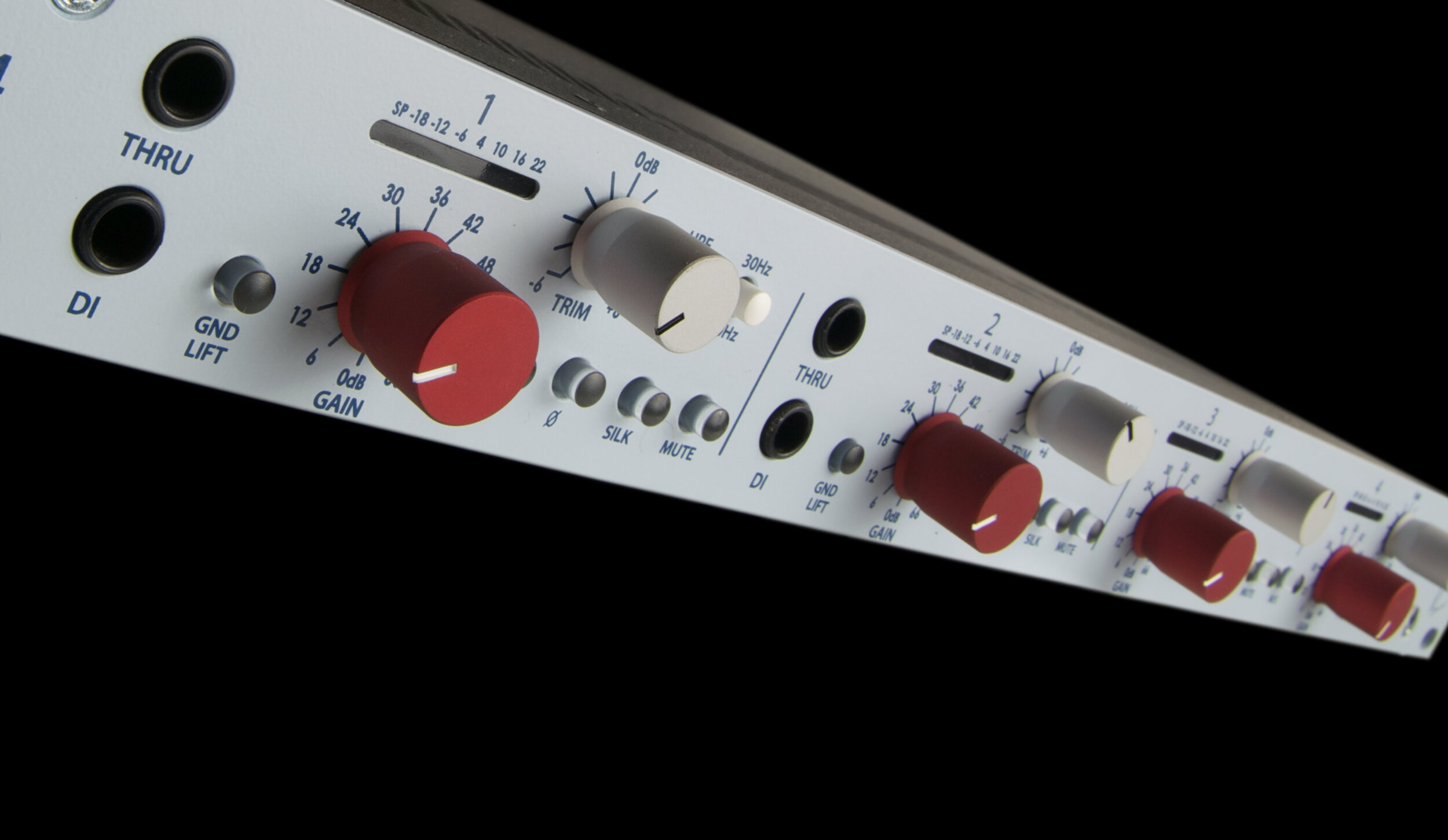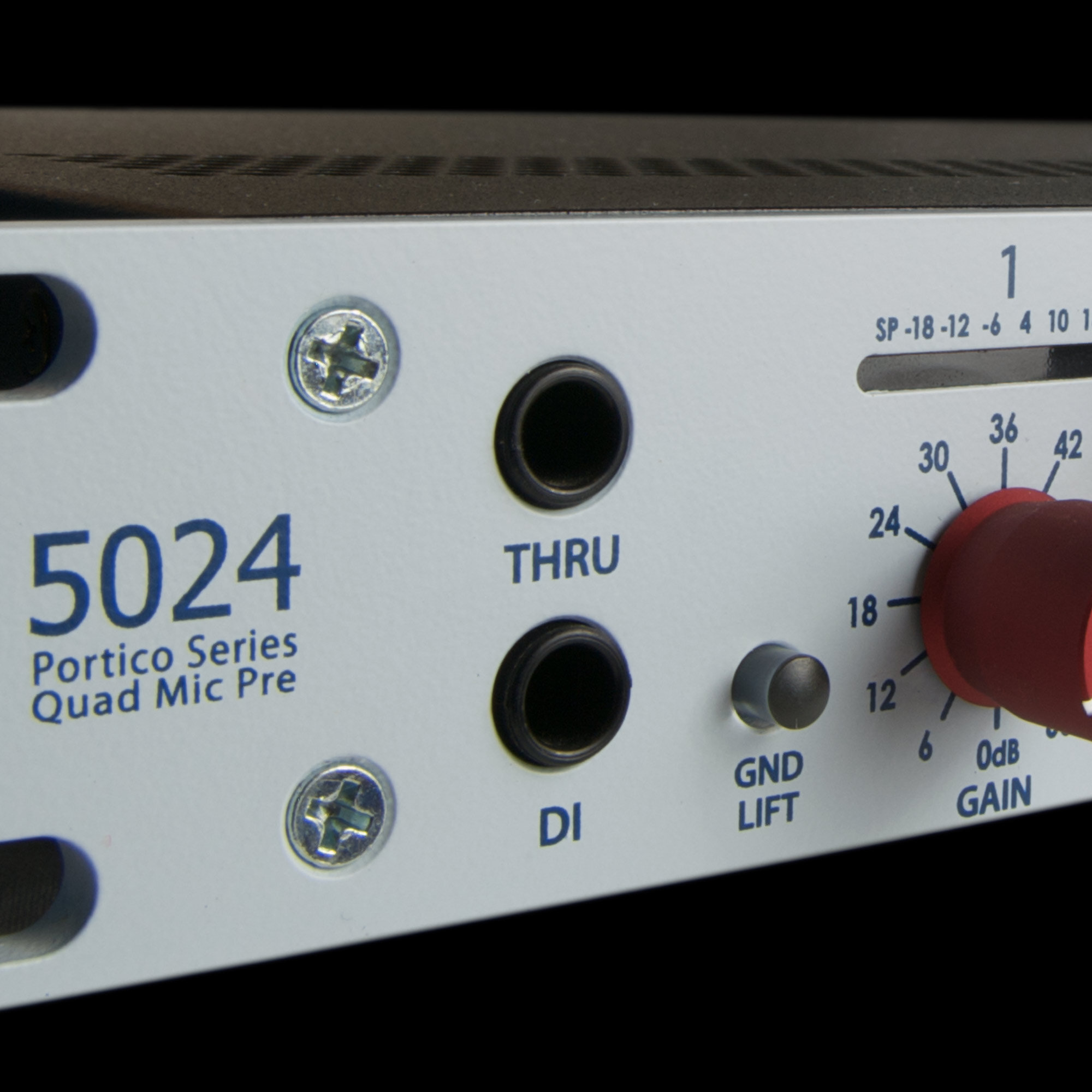
5024
Quad Mic Pre
DISCONTINUED
Four channels of legendary front-end tone.
Incorporating four channels of renowned preamplification, independent Silk controls, two channels of DI inputs, and an M-S Decoder into a 1U enclosure, the 5024 is a workhorse equipped to enhance the front end performance of any digital or analog recording system.
“Absolutely fantastic preamps!”
In addition to 72dB of gain, the 5024’s mic preamps include individually selectable phase, mute, phantom power, a selectable frequency high pass filter, custom transformers, and the Silk circuit which yields the rich warmth and presence of the renowned classic designs.
Channels 1 & 2 of the 5024 feature a high-Z direct input designed for instrument level sources.
Channels 3 & 4 feature an M-S switch, which enables built-in Mid-Side decoding without the use of external devices or console channels.
What is Silk?
One of the key features of the 5024 is the Silk circuit, which adds a specified amount of musical, pleasing harmonic saturation to the unit’s output stage. So how does it work?
By reducing negative feedback across the output transformer and adjusting this feedback’s frequency response, engaging the Silk switch provides the sweet, musical saturation found in Rupert’s legendary vintage designs.
MIC GAIN
A 12-way precision rotary switch controls gain from 0 to 66 dB in 6 dB steps.
TRIM
Continuously variable +/-6 dB level control.
PHANTOM POWER
Provides 48V phantom power to microphones.
POLARITY
Reverses the polarity of the input signal.
MUTE
Mutes the output signal.
SILK / TEXTURE
Pushing the Silk button engages the Silk circuit, which reduces the negative feedback on the output transformer, adding harmonic content and accentuating the saturation in the mid and high frequencies – similar to the effect of Silk Red on the Shelford Channel and other RND units. With Silk engaged, the distortion characteristic and harmonic content of the unit are very reminiscent of many of Rupert’s vintage class-A designs.
LED METERS
8-segment LED peak meters showing signal level on each channel.
HPF
Engages the high-pass filter circuitry.
30Hz / 90Hz
Selects between 30Hz and 90Hz for the high-pass filter frequency.
GROUND LIFT (Ch 1 & 2 only)
Lifts the ground connection on the DI input.
THRU (Ch 1 & 2 only)
Parallel THRU output for use with an external amplifier.
DI (Ch 1 & 2 only)
Transformer-isolated high-Z direct injection input.
M/S (Ch 3 & 4 only)
Changes channels 3 & 4 from independent to Mid (Ch3) and Side (Ch4)
REVIEWS
“Absolutely fantastic preamps!”
Matthew Sweet
“I spent a few days with the Portico 5024 using a variety of microphones and sound sources, and can report that these preamps are every bit as good as I thought they would be. They are crisp with a real presence that you really appreciate in vocal applications. The Portico 5024 preamps exhibit real depth with a smooth, full bottom-end reproduction that is faithful, rather than exaggerated or colored. The mid presence is nicely balanced, and the high frequencies detailed and musical with no harsh attributes. They are clean, but with a good dollop of character to lift them. The 5024 is a real delight. It is a high quality versatile pre-amplifier, and the DI and M/S facilities make it more attractive.”
Simon Tillbrook / Pro Sound Network
“Rupert Neve Designs knocked it out of the park with this one. I commend their achievement and thank the design team for such an incredible sound at the very-affordable price of less than $750 a channel.”
zoot / gearspace.com
“A must have! I have 3 of these. They sound great on everything!”
“Just got my second one, and plan on at least 2 more. These are great for everything. Incredibly clean clarity at all frequencies, and I find myself using silk on almost everything!”
“This one is amazing!! The sound in silk mode is second to none and it's great for traveling purposes. I use this in the studio and when I hit the road it's all I need to capture multi great sound audio tracks. A must for the serious professional recording projects that have to at times record on the road.”
Customer Reviews via sweetwater.com

SPECIFICATIONS & DOWNLOADS
FREQUENCY RESPONSE
Main Output, no load.
-0.2 dB @ 10 Hz
-3 dB @ 160 kHz
NOISE
Measured at Main Output, unweighted, 22 Hz - 22 kHz. Terminated 150 Ohm.
Terminated 150 Ohm.
With gain at unity better than -100 dBu
With gain at 66 dB better than -2 dBu
Equivalent Input Noise better than -128 dBu
Noise Factor 1.5 dB
HIGH PASS FILTER
FREQUENCY
80 Hz
SLOPE
12 dB/Octave Bessel
MAXIMUM OUTPUT LEVEL
From 20 Hz to 40 kHz is +26 dBu.
TOTAL HARMONIC DISTORTION AND NOISE
@ 1 kHz, +20 dBu main output: Better than 0.001%
@ 20 Hz, +20 dBu main output: Better than 0.002%
Silk Engaged: Better than 0.2% Second harmonic
CROSSTALK
Measured channel to channel: Better than -90 dB @ 15 kHz.
PHANTOM POWER
+48 Volts DC +/- 1%
POWER REQUIREMENTS
3-Pin EIC Input
100-240VAC
50/60Hz
.5 Amp
FREQUENTLY ASKED QUESTIONS
The Shelford Channel uses a direct-coupled transformer with gain for the mic preamp, which has some differing impedance and sonic characteristics as compared to the electronically balanced input found in the 5024.
However, the majority of harmonic content and sonic color associated with Rupert’s vintage modules actually comes from the output stage transformers, not the input stage – and this tonality can be added by engaging the Silk circuit on the 5024’s channels.
No, the RNDI is a unique design.
For M/S, recording engineers typically use a cardioid pattern for the Mid channel and a Figure 8 pattern aimed side-to-side for the Side channel. The most predictable results generally happen when the two mics are placed in very close proximity to one another, and are of similar design – so often two identical mics that have switchable patterns or swappable capsules are employed.
With the 5024, you have two options when recording in this mic configuration:
Don’t press the M/S button, and the 5024 will output the raw Mid and Side signals from the Channels 3 & 4 outputs respectively. This is helpful if you wish to decode to Left and Right later on in the mix process. Note: with this configuration, you can also use the 5024 to do the decoding later, as it will accept line level signals into the mic XLR inputs if the Gain switch is in the zero position and phantom is turned off.
Press the M/S button, and the 5024 will decode the M/S signal and output Channel 3 as Left and Channel 4 as Right, with their respective Gain switches used to control the balance of Mid and Side in this stereo output configuration.









